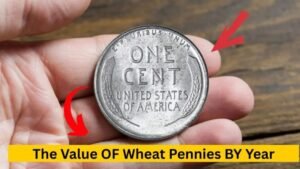The Lincoln Wheat Penny, a small coin with a big history, is catching the attention of collectors and everyday people alike. Some of these pennies, minted between 1909 and 1958, are worth a fortune—potentially up to $960,000! Even more exciting, these valuable coins might still be hiding in your pocket change, coin jars, or old collections. In this article, we’ll break down why certain Lincoln Wheat Pennies are so valuable, how to spot them, and what makes them special, all in simple language to help you understand this treasure hunt.
What Is the Lincoln Wheat Penny?
The Lincoln Wheat Penny is a one-cent coin produced by the United States Mint from 1909 to 1958. It’s named after President Abraham Lincoln, whose face is on the front (obverse), and the wheat stalks on the back (reverse), giving it the “Wheat Penny” nickname. These coins were common in everyday transactions for decades, but some rare versions are now worth a lot of money due to their scarcity, unique features, or minting errors.
Why Are Some Lincoln Wheat Pennies So Valuable?
Certain Lincoln Wheat Pennies are prized because of specific years, mint marks, or errors during production. Here’s why some of these coins can fetch prices as high as $960,000:
- Rarity: Some pennies were minted in very small quantities, making them hard to find today.
- Minting Errors: Mistakes during production, like double-stamped designs or missing letters, make certain coins unique.
- Condition: Coins in excellent condition (called “mint state”) are worth more because they’re well-preserved.
- Historical Significance: Special editions, like those from 1909, mark important moments in U.S. coin history.
Key Lincoln Wheat Pennies to Look For
To know if you have a valuable Lincoln Wheat Penny, you need to check three things: the year, the mint mark, and the condition. Below is a table of some of the most valuable Wheat Pennies and what makes them special.
| Year | Mint Mark | Why It’s Valuable | Estimated Value |
|---|---|---|---|
| 1909-S | S | First year of issue, low mintage | Up to $100,000+ |
| 1909-S VDB | S | Designer’s initials (VDB), very rare | Up to $960,000 |
| 1914-D | D | Low mintage, high demand | Up to $200,000 |
| 1922 No D | None | Mint mark error (missing “D”) | Up to $500,000 |
| 1931-S | S | Very low mintage | Up to $75,000 |
| 1943 Bronze | None or D/S | Minting error (bronze instead of steel) | Up to $800,000 |
| 1955 Double Die | None | Obvious double-stamped design | Up to $125,000 |
How to Identify a Valuable Lincoln Wheat Penny
Finding a valuable penny is like a treasure hunt. Here’s how you can check your coins:
- Look at the Year: Check the date on the front of the penny. Years like 1909, 1914, 1922, 1931, 1943, and 1955 are good starting points.
- Find the Mint Mark: Look for a small letter under the year. It could be:
- “S” (San Francisco)
- “D” (Denver)
- No letter (Philadelphia)
- Some rare coins, like the 1922 No D, are valuable because they’re missing the mint mark.
- Check for Errors: Look for unusual features, like doubled letters or numbers (e.g., 1955 Double Die) or a bronze 1943 penny (most 1943 pennies are silver-colored steel).
- Examine the Condition: Coins that look shiny, with clear details and no scratches, are worth more. Use a magnifying glass to inspect closely.
- Compare with Known Valuable Pennies: Use the table above or a coin guide to match your penny to known rare versions.
The 1909-S VDB: The Holy Grail of Wheat Pennies
One of the most famous Lincoln Wheat Pennies is the 1909-S VDB. This coin was minted in San Francisco (marked with an “S”) and includes the initials “VDB” for its designer, Victor David Brenner, on the back. Only 484,000 of these coins were made, making them extremely rare. In top condition, a 1909-S VDB penny can be worth up to $960,000 at auction!
The 1943 Bronze Error Penny
Another standout is the 1943 Bronze Penny. During World War II, pennies were made of steel to save copper for the war effort. However, a few bronze pennies were accidentally minted in 1943, making them incredibly rare. If you find a 1943 penny that’s bronze (not silver-colored), it could be worth hundreds of thousands of dollars.
Where to Find These Valuable Pennies
The exciting part? These rare pennies might still be in circulation! Here are some places to look:
- Pocket Change: Check your spare change from daily purchases.
- Coin Rolls: Buy rolls of pennies from banks and search through them.
- Old Coin Collections: Look through family heirlooms or old jars of coins.
- Flea Markets or Garage Sales: Sometimes, people sell old coins without knowing their value.
- Coin Shops or Shows: Visit local coin dealers or shows to find rare pennies or get your coins appraised.
Tips for Protecting Your Valuable Pennies
If you think you’ve found a rare Lincoln Wheat Penny, follow these steps to keep it safe:
- Handle with Care: Use gloves or hold the coin by its edges to avoid damaging it with oils from your fingers.
- Store Properly: Keep the coin in a protective holder or sleeve to prevent scratches.
- Get It Appraised: Take your coin to a professional coin dealer or grading service like PCGS or NGC to verify its authenticity and value.
- Avoid Cleaning: Cleaning a coin can lower its value. Leave it as is, even if it’s dirty.
How to Sell a Valuable Lincoln Wheat Penny
If you have a rare penny, you might want to sell it. Here’s how:
- Get It Graded: Professional grading services will evaluate your coin’s condition and authenticity, which can increase its value.
- Visit a Coin Dealer: Local dealers can give you an estimate or buy the coin directly.
- Auction It: High-value coins often sell for more at auctions, like those run by Heritage Auctions or Sotheby’s.
- Online Marketplaces: Websites like eBay can work, but be cautious and ensure the buyer is reputable.
Why Collectors Love Lincoln Wheat Pennies
Collectors are drawn to these pennies because they combine history, rarity, and the thrill of discovery. The Lincoln Wheat Penny was the first U.S. coin to feature a real person (Abraham Lincoln), and its long production run (1909–1958) makes it a nostalgic piece of Americana. Plus, the possibility of finding a $960,000 coin in your change keeps the excitement alive!
Conclusion
The Lincoln Wheat Penny is more than just a piece of pocket change—it’s a potential goldmine. With some versions worth up to $960,000, these coins are a reminder that treasures can hide in plain sight. By checking the year, mint mark, and condition of your pennies, you could uncover a rare gem like the 1909-S VDB or 1943 Bronze Penny. Start searching your change, old coin jars, or local coin shops, and you might just find a small fortune!
FAQs About Lincoln Wheat Pennies
What makes a Lincoln Wheat Penny valuable?
A penny’s value depends on its year, mint mark, condition, and any minting errors. Rare coins like the 1909-S VDB or 1943 Bronze Penny are worth the most due to low production or mistakes during minting.
How can I tell if my penny is rare?
Check the year and mint mark (a small letter under the year). Look for errors like doubled designs or unusual materials (e.g., a bronze 1943 penny). Compare your coin to a guide or get it appraised by a professional.
Where can I find rare Lincoln Wheat Pennies?
Look in your pocket change, bank coin rolls, old family collections, or at flea markets. Coin shops and shows are also great places to search or get appraisals.
Should I clean my penny to make it worth more?
No, cleaning a coin can damage it and lower its value. Leave it as is and let a professional grader assess it.
How do I sell a rare penny?
Get your coin graded by a service like PCGS or NGC, then sell it through a reputable coin dealer, auction house, or online marketplace like eBay.
Are all Lincoln Wheat Pennies valuable?
Not all are valuable. Most are worth only a few cents, but specific years, mint marks, or errors (like 1909-S VDB or 1943 Bronze) can be worth thousands or even $960,000.




